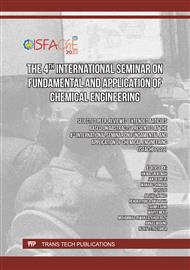[1]
H. Li, S. Legere, Z. He, H. Zhang, J. Li, B. Yang, S. Zhang, L. Zhang, L. Zheng, Y. Ni, Methods to increase the reactivity of dissolving pulp in the viscose rayon production process: a review, Cellulose. 25 (2018) 3733–3753.
DOI: 10.1007/s10570-018-1840-1
Google Scholar
[2]
A.B.M. Abdullah, M. Abony, M.T. Islam, M.S. Hasan, M.A.K. Oyon, M.B. Rahman, Extraction and proximate study of sansevieria trifasciata l. as fibre source for textile and other uses, J. Asiat. Soc. Bangladesh, Sci. 46 (2020) 155–162.
DOI: 10.3329/jasbs.v46i2.54411
Google Scholar
[3]
S. Tripathi, O.P. Mishra, A. Gangwar, S.K. Chakrabarti, R. Varadhan, Impact of wood storage on pulp and paper making properties, IPPTA J. 23 (2011) 161–164.
Google Scholar
[4]
C.A. Purwita, S. Sugesty, Pembuatan dan karakterisasi dissolving pulp serat panjang dari bambu duri (bambusa blumeana), J. Selulosa. 8 (2018) 21–32.
DOI: 10.25269/jsel.v1i01.232
Google Scholar
[5]
A.G. Adeniyi, S.A. Adeoye, J.O. Ighalo, Sansevieria Trifasciata Fibre and Composites: A review of recent developments, Int. Polym. Process. 35 (2020) 344–354.
DOI: 10.3139/217.3914
Google Scholar
[6]
M. Kanimozhi, Investigating the physical characteristics of Sansevieria trifasciata fibre, Int. J. Sci. Res. Publ. 1 (2011) 1–4.
Google Scholar
[7]
R. Maryana, A. Nakagawa-izumi, M. Kajiyama, H. Ohi, Environment-friendly non-sulfur cooking and totally chlorinefree bleaching for preparation of sugarcane bagasse cellulose, J. Fiber Sci. Technol. 73 (2017) 182–191.
DOI: 10.2115/fiberst.2017-0025
Google Scholar
[8]
H. Harsono, A.S. Putra, R. Maryana, A.T. Rizaluddin, Y.Y. H'ng, A. Nakagawa-izumi, H. Ohi, Preparation of dissolving pulp from oil palm empty fruit bunch by prehydrolysis soda-anthraquinone cooking method, J. Wood Sci. 62 (2016) 65–73.
DOI: 10.1007/s10086-015-1526-3
Google Scholar
[9]
E.G. Aklilu, Optimization and modeling of ethanol–alkali pulping process of bamboo (Yushania alpina) by response surface methodology, Wood Sci. Technol. 54 (2020) 1319–1347.
DOI: 10.1007/s00226-020-01188-z
Google Scholar
[10]
T211 om-12 (2012) Ash in wood, pulp, paper and paperboard. TAPPI, Atlanta GA, USA. Information on http:// www.tappi.org/Bookstore/Standards-TIPs/Standards/.
Google Scholar
[11]
T204 cm-07 (2007) Solvent extractives of wood and pulp. TAPPI, Atlanta GA, USA. Information on http://www.tappi.org/Bookstore/Standards-TIPs/Standards.
Google Scholar
[12]
T222 om-11 (2011) Acid-insoluble lignin in wood and pulp. TAPPI, Atlanta GA, USA. Information on http://www.tappi.org/Bookstore/Standards-TIPs/Standards/.
Google Scholar
[13]
T236 om-13 (2013) Kappa number of pulp. TAPPI, Atlanta GA, USA. Information on http://www.tappi.org/Bookstore/Standards-TIPs/Standards/.
Google Scholar
[14]
T230 om-13 (2013) Viscosity of pulp (capillary viscometer method). TAPPI, Atlanta GA, USA. Information on http://www.tappi.org/Bookstore/Standards-TIPs/Standards/.
Google Scholar
[15]
T452 om-08 (2008) Brightness of pulp, paper and paperboard (Directional reflectance at 457 nm). TAPPI, Atlanta GA, USA. Information on http://www.tappi.org/Bookstore/Standards TIPs/Standarsds/.
DOI: 10.1520/d0985-97
Google Scholar
[16]
T203 cm-09 (2009) Alpha-, beta- and gamma-cellulose in pulp. TAPPI, Atlanta GA, USA. Information on www://tappi.org/Bookstore/Standards-TIPs/Standards/.
Google Scholar
[17]
O. Komala, I. Yulia, R. Pebrianti, Uji efektivitas ekstrak etanol daun lidah mertua (Sansevieria trifasciata Prain) terhadap khamir Candida albicans, FITOFARMAKA J. Ilm. Farm. 2 (2012) 146–152.
DOI: 10.33751/jf.v2i2.169
Google Scholar
[18]
T.E. Tallei, R.E. Rembet, J.J. Pelealu, B.J. Kolondam, Sequence variation and phylogenetic analysis of Sansevieria trifasciata (Asparagaceae), Biosci. Res. 13 (2016) 1–7.
Google Scholar
[19]
B. Mohr Giesbrecht, R. Coldebella, M. Genti, G.R. Santana Nunes, M. Redel Finger, J. Marangon Jardim, C. Pedrazzi, G. Valimv Cardoso, The performance of Acacia mearnsii De Wild for kraft pulping, Ciência Florest. 32 (2022).
DOI: 10.5902/1980509850295
Google Scholar
[20]
M. Nakamura, M. Ohzono, H. Iwai, K. Arai, Anthracnose of Sansevieria trifasciata caused by Colletotrichum sansevieriae sp. nov, J. Gen. Plant Pathol. 72 (2006) 253–256.
DOI: 10.1007/s10327-006-0280-1
Google Scholar
[21]
Zulniati, Journal of Chemical Information and Modeling. 53(2018) 123-131
Google Scholar
[22]
S. Suhartati, A. Rahmayanti, A. Junaedi, E. Nurrohman. Sebaran dan persyaratan tumbuh jenis alternatif penghasil pulp di wilayah riau. Kementerian Kehutanan. Badan Penelitian dan Pengembangan Kehutanan, Jakarta, (2012)
DOI: 10.20886/jklh.2018.12.1.32-41
Google Scholar
[23]
Suharsi, T.K. dan N. Andiani. 2013. Buletin Agrohorti. Volume 1 No 1 (2013) 89-93.
Google Scholar
[24]
A.T. Rizaluddin, Q. Liu, P.R. Panggabean, H. Ohi, K. Nakamata, Application of peroxymonosulfuric acid as a modification of the totally chlorine-free bleaching of acacia wood prehydrolysis-kraft pulp, J. Wood Sci. 61 (2015) 292–298.
DOI: 10.1007/s10086-015-1465-z
Google Scholar
[25]
SNI 0938:2010, Pulp rayon (in Indonesian), information on http://www.sisni.bsn.go.id/index.php?/sni_main/sni/detail_sni/9701.
DOI: 10.13072/midss.464
Google Scholar
[26]
M.F. Andrade, J.L. Colodette, Dissolving pulp production from sugar cane bagasse, Ind. Crops Prod. 52 (2014) 58–64.
DOI: 10.1016/j.indcrop.2013.09.041
Google Scholar
[27]
P.Z. Uchôa, R.C.T. Porto, R. Battisti, C. Marangoni, N. Sellin, O. Souza, Ethanol from residual biomass of banana harvest and commercialization: A three-waste simultaneous fermentation approach and a logistic-economic assessment of the process scaling-up towards a sustainable biorefinery in Brazil, Ind. Crops Prod. 174 (2021) 114170.
DOI: 10.1016/j.indcrop.2021.114170
Google Scholar
[28]
Matin M., Rahman M.M., Nayeem J., Sarker A.M., Dissolving pulp from jute stick, Carbohydrate Polymers.115(26) 2015, 44-48.
DOI: 10.1016/j.carbpol.2014.08.090
Google Scholar
[29]
C.A. Purwita, S. Sugesty, Pembuatan dan karakterisasi dissolving pulp serat panjang dari bambu duri (Bambusa blumeana), J. Selulosa. 8 (2018) 21–32.
DOI: 10.25269/jsel.v1i01.232
Google Scholar



